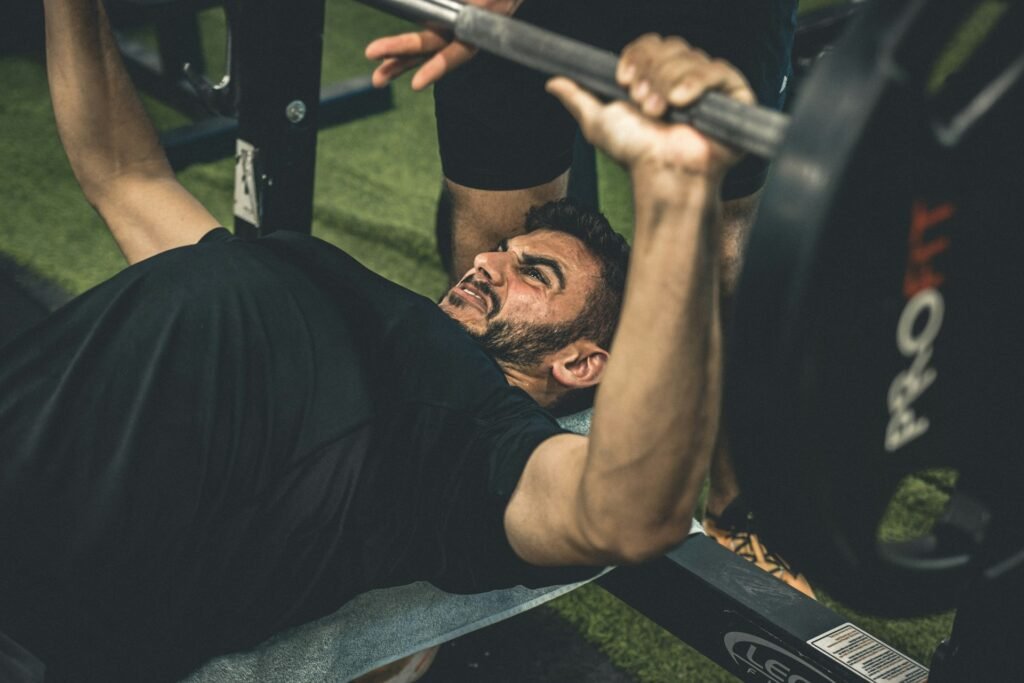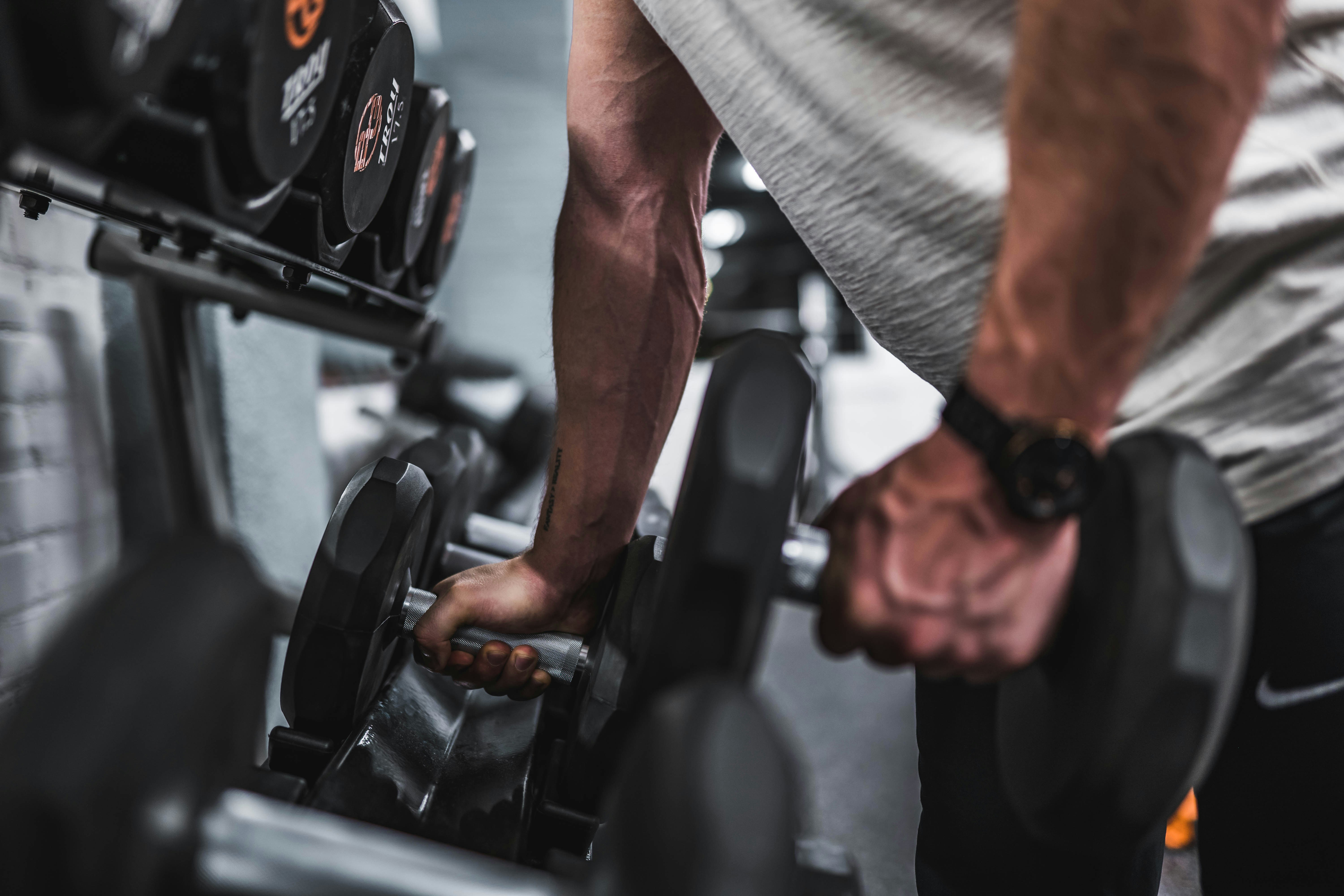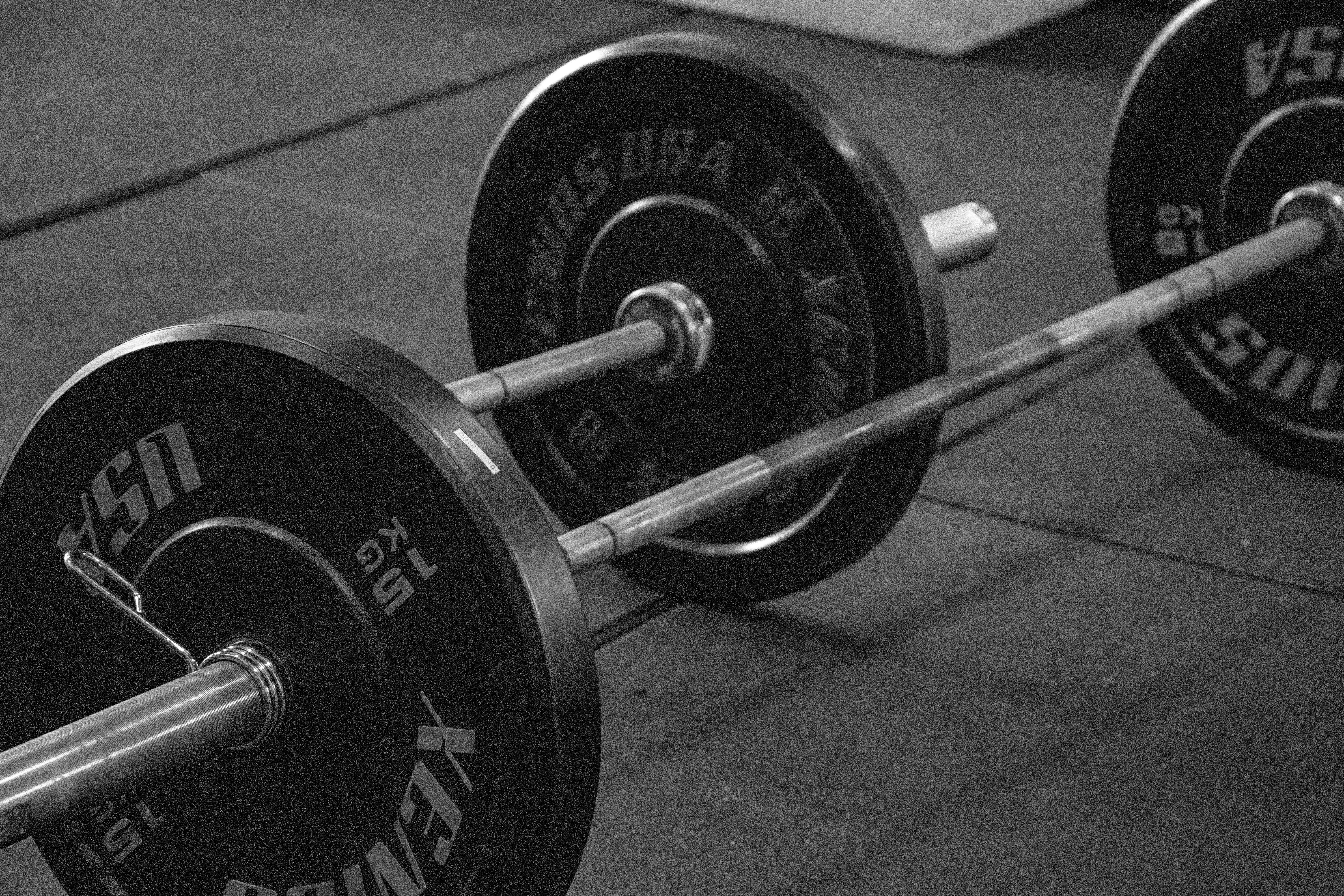
Photo by Shoham Avisrur on Unsplash
There are different variations of the bench press, each with unique benefits and techniques. The two most common types are the dumbbell and barbell bench press.
Dumbbell Bench Press
The dumbbell bench press allows for a greater range of motion compared to the barbell version. This means your muscles, particularly the pectorals, can work through a more extensive movement path. Tony Gentilcore, C.S.C.S., points out that using dumbbells ensures both arms work equally, helping to correct muscular imbalances [^1]. Another advantage is that dumbbells enable a more natural, free movement, reducing stress on the shoulder joints.
Barbell Bench Press
On the other hand, the barbell bench press is ideal for lifting heavier weights, making it suitable for those aiming to build maximum strength. Most gyms have barbells that can accommodate more weight than dumbbells, which typically max out at around 100 pounds [^1]. Albert Matheny, R.D., C.S.C.S., mentions that barbells are also more stable, allowing for better control during the lift. However, it’s crucial to have a spotter for safety, especially when lifting heavy.
Incorporating both variations in your routine can provide a balanced approach to developing upper body strength. For more insights into maximizing your workouts and understanding their effects, consider checking our related article on Steady-State Cardio Examples.
References
[^1]: Nike. “Does It Matter if You Bench-press With Dumbbells or a Barbell?” Retrieved from Nike’s Website.
Dumbbell Bench Press: Techniques and Tips

Photo by Anastase Maragos on Unsplash
The dumbbell bench press is a fantastic exercise for building your chest muscles. Proper technique is crucial for maximizing its benefits while minimizing the risk of injury. Here are some key techniques and tips to perfect your form:
Setup and Form
- Arm Path Alignment: Align your arm path with the direction of your chest fibers. Tuck your elbows to a 45 to 60-degree angle away from your body to increase chest muscle activation and reduce the risk of shoulder injuries.
- Shoulder Positioning: Pinch your shoulder blades together and keep your chest up to maximize chest activation. Avoid rounding your shoulders forward to prevent shifting the load to your front delts.
- Top Position: Stop once your arms are straight over your shoulders, rather than bringing the dumbbells together at the top, to maintain constant chest tension.
- Bench Angle: Use a flat bench to target the mid-chest. Incorporate incline (15 to 30 degrees) or decline variations to target the upper and lower chest for balanced development.
Execution
- Descent: Lower the dumbbells slowly and in control, aiming to bring them in line with your chest. Ensure that your elbows do not flare out excessively.
- Pressing: Press the dumbbells back up in a straight line, extending your elbows without locking them completely. Focus on maintaining a controlled and steady movement throughout.
Tips and Tricks
- Focus on Technique: Prioritize good form over the amount of weight lifted to prevent injury. Incorrect form can lead to shoulder pain or serious injury.
- Flared Elbows: Avoid letting your elbows flare out too much to reduce the risk of shoulder injuries.
- Controlled Movement: Control the descent and avoid bouncing the dumbbells off your chest. Maintain tension in your chest muscles throughout the exercise.
Barbell Bench Press: Techniques and Tips

Photo by Benjamin Brunner on Unsplash
The barbell bench press is a popular and effective exercise that targets the chest, shoulders, and triceps. Here are some techniques and tips to get the most out of this essential workout:
Setup and Form
- Lay Flat: Start by laying flat on a bench, ensuring your feet are planted firmly on the floor.
- Hand Positioning: Grip the barbell just outside shoulder width. This positioning helps maintain balance and control.
- Shoulder Blades: Pinch your shoulder blades together and drive them into the bench. This helps in stabilizing your upper body and protecting your shoulders.
- Breath Control: Take a deep breath before unracking the bar to keep your core tight.
Execution
- Liftoff: With the help of a spotter, lift the bar off the rack while maintaining tightness in your upper back.
- Descent: Lower the bar slowly and in control, aiming for your sternum. Ensure that your elbows do not flare out excessively.
- Pressing: Press the bar back up in a straight line by pushing yourself into the bench and driving your feet into the floor. Extend your elbows without locking them completely.
Tips and Tricks
- Focus on Technique: Prioritize good form over the amount of weight lifted to prevent injury. Incorrect form can lead to shoulder pain or even serious injury.
- Flared Elbows: Avoid letting your elbows flare out too much as this can increase the risk of shoulder injuries.
- Bouncing the Bar: Do not bounce the bar off your chest. Always control the descent and touch the chest lightly.
- Leg Drive: Utilize leg drive by pushing your feet into the floor to help stabilize your body and generate more power.
Following these techniques and tips will lead to a safer and more effective barbell bench press, whether you are a beginner or an experienced lifter.
Comparing the Muscle Activation
When comparing muscle activation between the dumbbell bench press and the barbell bench press, it’s important to look at the specific muscles involved in each exercise. According to a study published in the Journal of Sports Science and Medicine, the barbell bench press activates the pectoralis major by 16% more on average compared to dumbbell flyes during the entire movement source.
This higher activation extends to the anterior deltoids and the triceps brachii as well. Specifically, the barbell bench press elicits 25% more muscle activation in the anterior deltoids and 75% more in the triceps brachii throughout the entire range of motion source. This can be attributed to the different biomechanics and stabilization demands imposed by the use of a barbell, which allows for greater overall load and a more stable path of motion.
On the other hand, the dumbbell bench press tends to engage the biceps brachii significantly more. The study found that the biceps brachii activation was 76% higher during the dumbbell bench press compared to the barbell bench press. This increased activation is likely due to the individual control required for each arm, which acts to stabilize the weights independently.
For those looking to isolate the pectoralis major and increase their upper body strength, the barbell bench press appears to be more effective. However, for enhancing muscle balance and engaging stabilizing muscles like the biceps brachii, incorporating the dumbbell bench press into your routine would be beneficial.
For more information on upper body workouts and their benefits, you can explore related exercises and routines in our article on dynamic dumbbell chest workouts.
Impact on Joint Health and Safety
When comparing the dumbbell and barbell bench presses, joint health and safety are key considerations. Bench pressing with dumbbells generally allows for a greater range of motion and can help reduce the risk of shoulder injuries. This is because dumbbells enable a more natural movement pattern, allowing your wrists, elbows, and shoulders to move independently. As a result, many find that the dumbbell variation places less stress on the shoulder joint.
In contrast, the barbell bench press tends to be more restrictive. Since your hands are fixated on the barbell, your shoulders can be forced into a static position, which can increase the risk of shoulder impingements over time. However, using proper technique and gradually increasing weight can help mitigate these risks.
A study published on the effectiveness of joint health and safety measures highlights the importance of targeted training and awareness to reduce workplace injuries PubMed. Applying similar principles, focusing on proper form and joint-friendly variations like dumbbell presses can be beneficial for long-term joint health.
For those concerned about joint health, especially if you have pre-existing shoulder issues, incorporating low-impact cardio exercises can be a good complementary practice. Check out our guide on low-impact cardio for bad knees for more information.
Choosing Based on Fitness Goals
When it comes to selecting between the dumbbell bench press and the barbell bench press, your fitness goals play a crucial role. Understanding what you aim to achieve can guide you to the most suitable exercise.
Muscle Imbalance and Stabilization: If your goal is to address muscle imbalances and improve stabilization, the dumbbell bench press may be the better option. According to fitness experts, dumbbells engage more stabilizing muscles, as each arm works independently. This can help improve lower body symmetry and overall muscle coordination Canyon Ranch.
Strength and Power: On the other hand, if you are aiming to build maximal strength and power, the barbell bench press might be more effective. The barbell allows you to lift heavier weights, as both arms are working together, supporting each other. This can lead to greater strength gains, which is beneficial for power-focused athletes.
Range of Motion and Flexibility: Individuals who are focused on increasing their range of motion and working on flexibility might prefer the dumbbell bench press. Dumbbells allow for a greater range of motion compared to a barbell, which can enhance muscle flexibility and reduce the risk of injury.
Specificity to Sporting Performance: For athletes, the choice may depend on the demands of their specific sport. For example, rugby players might benefit more from barbell lifts due to the need for overall power, whereas sports that require unilateral strength (like tennis) might benefit more from dumbbell exercises.
Setting SMART (Specific, Measurable, Attainable, Relevant, Time-bound) goals can help in choosing the right exercise. For example, if increasing bench press weight by 10% in three months is your goal, then barbell bench press might be the way to go.
Check out more related workouts to target your fitness goals, like the full body barbell workout on our site.
Conclusion: Making the Best Choice for You
Choosing between the dumbbell and barbell bench press depends on several factors including your fitness goals, experience level, and any existing joint issues. Both exercises offer substantial benefits and can be incorporated effectively into a well-rounded strength training routine.
For those aiming to build balanced muscle strength and improve joint health, the dumbbell bench press might be the better option. This exercise allows for a greater range of motion and more natural movement, reducing the risk of shoulder and elbow injuries. According to a study published in the Journal of Strength and Conditioning Research, participants using dumbbells demonstrated 15% more muscle activation in the stabilizing muscles compared to those using barbells [^1].
On the other hand, if your goal is to lift heavier weights and maximize upper body strength, the barbell bench press provides a more stable platform. This stability lets you progressively increase the weight and hit your strength goals faster. In a similar study, individuals using barbells were able to lift approximately 20-30% more weight compared to those using dumbbells [^1].
Ultimately, the choice is personal and should align with your individual fitness journey. If you’re looking for more tips on integrating cardio into your strength training, check out our guide on how long to wait to do cardio after lifting weights. This can help you balance your routine and avoid overtraining.
[^1]: Conclusions, Choices, Compelling, But I Chose the “La mejor”
Keep in mind, it’s not about making the right choice, but about making your choice right. Evaluate your goals, listen to your body, and don’t be afraid to switch things up as needed.